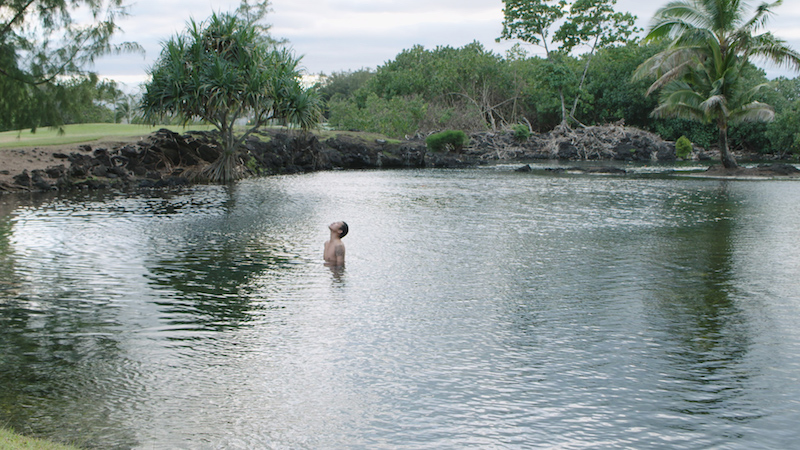Set in a breezy village on the Big Island of Hawai‘i, August at Akiko’s carries dramatic weight without sacrificing the tranquil solemnity on which the film’s moody, dreamlike disposition is built.
August at Akiko’s, which premiered at the Rotterdam Film Festival in 2018, is Hawai‘i-born filmmaker Christopher Makoto Yogi’s full-length directorial debut. Running at a relatively quick 75-minutes, the film is short but sweet – a compact feature that still makes room to breathe. Yogi takes his time, indulging in longwinded stationary and panning shots, capturing the rural island and its people as they are, moving at a pace that drives the plot forward but conjures the film’s relaxed, dreamy tone.
Alex Zhang Hungtai (better known by his stage names, formerly Dirty Beaches, now Last Lizard) plays himself—or rather a version of himself—a traveling musician who returns to Hawai‘i Island where he grew up after a decade of estrangement, in search of his family, his childhood, and his home. What he finds instead is a bed and breakfast run by Akiko (Akiko Masuda, who also plays herself), where he continues his search for home. If you think this description sounds vague, it intentionally is. Yogi’s barebones, deceivingly-light screenplay produced a film with an enormous amount of depth, focusing more on the visceral experience of the film and its characters’ interaction and development rather than the plot itself.
As with any movie, music and sound design are as important as the picture on screen. However, August at Akiko’s puts a bold emphasis on the musical compositions, the different songs and sounds, whether it be through Alex’s brooding sax solo’s or Akiko’s gently melodic Buddhist bell tones, are expressions of and companions to the characters themselves. The thoughtfulness of the musical score is owed to the film’s star, Alex Hungtai. In addition to acting in his first feature length film, Hungtai provided the post-jazz/new-wave soundtrack. Hungtai’s score coupled with impeccable sound design floats its audience through the film – gliding on frog croaks and ocean waves, and the still sound of nature observed. White noise ceases to simply be white noise for a film in which sound design is treated with as much conscious consideration as the directions of the camera, creating an audible element so powerful and explicit, the viewer could just as well grasp the deep mood of the film with their eyes closed.
The concept of time is essential to August at Akiko’s in terms of plot and technique. Yogi shows Akiko’s tranquil relationship to time by devoting entire scenes to meditation sequences, her daily routine of striking bells at the same exact hour daily. Likewise, the depiction of time from Alex’s perspective is present in extended saxophone solos and meditation scenes that mirror Akiko’s. At the center of the narrative is Alex coping with the consequences of time itself—time that he has spent away from his childhood home, and how he may reclaim that time as an adult in order to find peace.
While time is integral to the film in terms of plot and technique, it is also used by Yogi to skew the viewer’s perception of reality—very few lengths of time are actually defined. For example, in having Alex’ wardrobe remain the same throughout his stay, Yogi obscures the amount of time Alex actually spends with Akiko. This withholding of timeline clues – further obscured by gaping cinematography and leisurely camera movements – expands the dreamlike quality, leading the audience to question where real ends and the surreal begins.
Watching August at Akiko’s is like watching a film of opposites coalescing together—the real and the surreal, the ephemeral and the eternal. It is a movie experience comprised equally of sight and sound, dream and reality. All components combine, yield, and meld to each other in a way that makes August at Akiko’s an earnest yet engaging movie experience for its viewers and a quiet, ever-humble gift to modern filmmaking.

